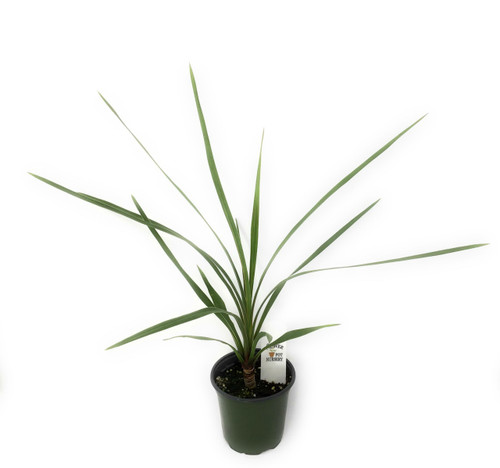(Red Grass Palm) - Grown as an immature plant for the ornamental trade, this plant fittingly desires its place as a centerpiece / upright focal plant that shows best in a container surrounded by vining/ trailing flowering plants. It is a palm-like, sub-tropical tree that grows with an upright habit and with age will branch to produce several heads. This cultivar has very dark reddish-bronze sword-like strap leaves. This plant has the potential to grow as large as 20 to 25 feet tall, but this cultivar is not as vigorous of the species and will remain 10 feet tall with time. It will produces large panicles of small, intensely sweet-scented flowers in late spring to summer. Best in full sun to light shade - some shade protection necessary in hotter climates. It is drought tolerant. A useful specimen in dry gardens offering a tropical look. It is hardy to 15° F, growing well in USDA zones 8-10.
Cordyline australis, commonly known as the cabbage tree, cabbage-palm or tī kōuka, is a widely branched monocot tree endemic to New Zealand.
It grows up to 20 metres (66 feet) tall with a stout trunk and sword-like leaves, which are clustered at the tips of the branches and can be up to 1 metre (3.3 feet) long. With its tall, straight trunk and dense, rounded heads, C. australis is a characteristic feature of the New Zealand landscape. Its fruit is a favourite food source for the New Zealand pigeon and other native birds. It is common over a wide latitudinal range from the far north of the North Island at 34° 25'S to the south of the South Island at 46° 30'S. Absent from much of Fiordland, it was probably introduced by Māori to the Chatham Islands at 44° 00'S and to Stewart Island at 46° 50'S. It grows in a broad range of habitats, including forest margins, river banks and open places, and is abundant near swamps. The largest known tree with a single trunk is growing at Pakawau, Golden Bay. It is estimated to be 400 or 500 years old, and stands 17 metres (56 feet) tall with a circumference of 9 metres (30 feet) at the base.
Known to Māori as tī kōuka, the tree was used as a source of food, particularly in the South Island, where it was cultivated in areas where other crops would not grow. It provided durable fibre for textiles, anchor ropes, fishing lines, baskets, waterproof rain capes and cloaks, and sandals. Hardy and fast growing, C. australis is widely planted in New Zealand gardens, parks and streets, and numerous cultivars are available. The tree can also be found in large numbers in island restoration projects such as Tiritiri Matangi Island, where it was among the first seedling trees to be planted.
It is also grown as an ornamental tree in Northern Hemisphere countries with mild maritime climates, including parts of the upper West Coast of the United States and the warmer parts of the British Isles, where its common names include Torbay palm and Torquay palm. It does not do well in hot tropical climates like Queensland, Southeast Asia and Florida.
Immature forms have become a popular annual house or ornamental plant under the name 'Spikes', or Dracaena 'Spikes'. To add to the confusion, these may be misidentified as Cordyline indivisa (syn. Dracaena indivisa).
Give credit where credit is due: Wikipedia 2020
FlowerPotNursery Pink Dracaena Cordyline australis Pink 4" Pot
The Flower Pot Nursery
$8.99
- SKU:
- PDCA040920










